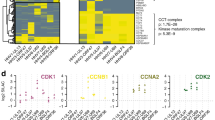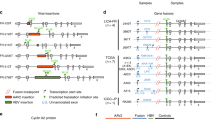Abstract
Cyclins are major cell cycle regulators which role in malignant transformation remains controversial. In this report we describe a new mechanism of cyclin oncogenic activation. We demonstrate that an altered form of cyclin A2 (S2A) which N-terminal part is replaced by the hepatitis B virus envelope protein transforms normal rat kidney cells and cooperates with ras to transform rat embryo fibroblasts. In contrast, neither the viral moiety, nor a full length or N-terminally deleted cyclin A2 show these oncogenic properties. S2A oncogenicity arises from its binding to cyclin dependent kinases, since mutation in the MRAIL sequence abolishes transformation and correlates with an abnormal cellular localization in the endoplasmic reticulum membrane. Together, these results implicate modification in the cellular distribution of a cell cycle regulator as a mechanism of virally-induced transformation.
Similar content being viewed by others
Author information
Authors and Affiliations
Rights and permissions
About this article
Cite this article
Berasain, C., Patil, D., Perara, E. et al. Oncogenic activation of a human cyclin A2 targeted to the endoplasmic reticulum upon Hepatitis B virus genome insertion. Oncogene 16, 1277–1288 (1998). https://doi.org/10.1038/sj.onc.1201893
Received:
Revised:
Accepted:
Published:
Issue Date:
DOI: https://doi.org/10.1038/sj.onc.1201893
- Springer Nature Limited
Keywords
This article is cited by
-
Recurrent AAV2-related insertional mutagenesis in human hepatocellular carcinomas
Nature Genetics (2015)
-
In the wrong place at the wrong time: does cyclin mislocalization drive oncogenic transformation?
Nature Reviews Cancer (2013)
-
Walleye dermal sarcoma virus: expression of a full-length clone or the rv-cyclin (orf a) gene is cytopathic to the host and human tumor cells
Molecular Biology Reports (2013)
-
Cyclin A2
AfCS-Nature Molecule Pages (2007)
-
Regulation of the cyclin A1 protein is associated with its differential subcellular localization in hematopoietic and leukemic cells
Oncogene (2004)




